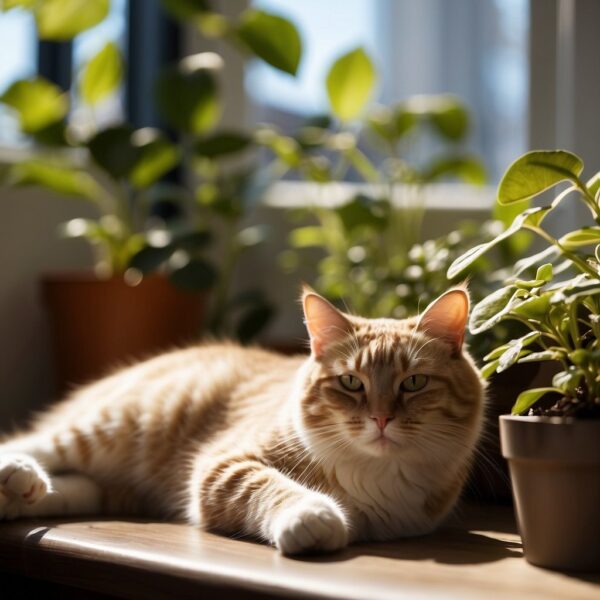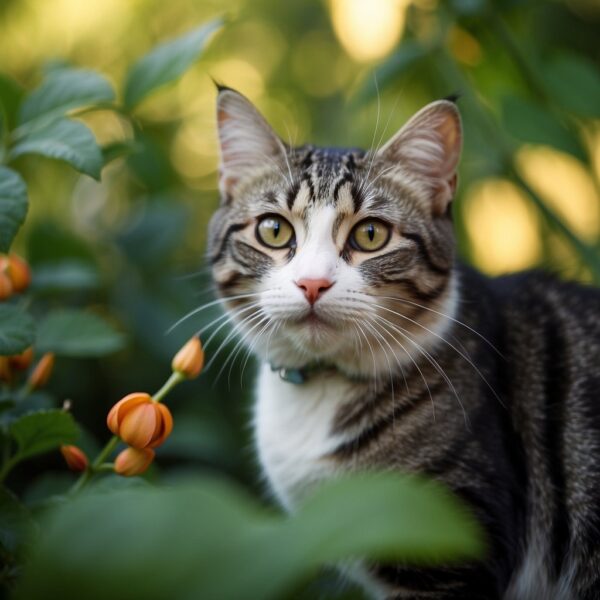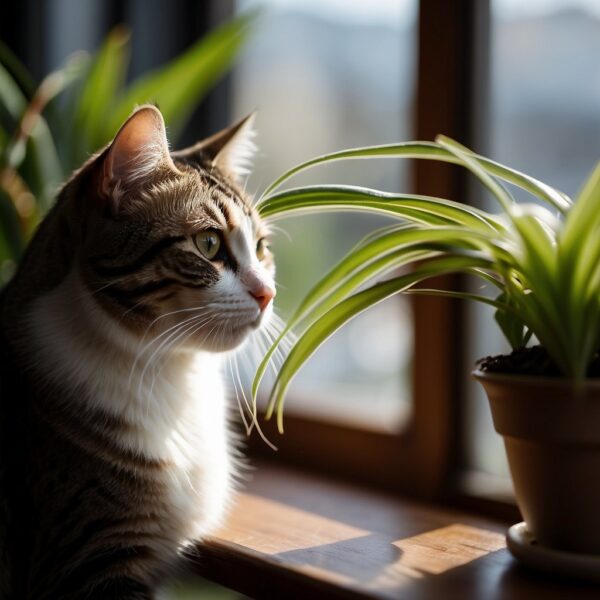
Silvervine for Cats: A Catnip Alternative
Silvervine, a climbing plant native to Asia, is steadily emerging as an alternative to catnip for feline amusement and enrichment. Recognized for eliciting a profound reaction, silvervine contains compounds that can dramatically affect a cat’s behavior, usually leading to energetic play and occasional euphoria. This intriguing reaction is mainly due to two active ingredients found in silvervine—actinidine and dihydroactinidiolide—which are effective for most cats, including those that show indifference to catnip.
As cat parents increasingly seek ways to improve the well-being of their indoor cats, silvervine presents a natural option to encourage exercise and play while also offering stress relief and potential dental health benefits. Chewing on silvervine sticks, for example, is thought to assist in removing plaque build-up on a cat’s teeth. Moreover, unlike some commercially available toys and treats, silvervine is not considered addictive for cats, making it a safe choice for regular enjoyment.
Key Takeaways
- Silvervine is an effective cat attractant that can stimulate active play and relieve stress.
- It is considered safe for cats and not addictive, offering a natural option for cat entertainment.
- Compared to catnip, silvervine has a higher likelihood of eliciting a positive reaction in cats.
Understanding Cats’ Reaction to Silvervine
Silvervine, scientifically known as Actinidia polygama, garners significant reactions from cats, akin to the response evoked by catnip, but often stronger. This section explores the interaction between cats and silvervine and delves into the scientific basis for their responses.
How Cats Interact with Silvervine
Cats exhibit a variety of behaviors when exposed to silvervine, and these reactions can range from euphoric excitement to a state of calm relaxation. When provided with silvervine sticks or silvervine powder, a responsive cat may exhibit the following:
- Rolling: Showing a sign of enjoyment, cats will often roll on or rub against silvervine.
- Chewing: Silvervine sticks are particularly attractive for chewing, contributing to dental health by aiding in the removal of tartar.
- Drooling: Some cats may drool as a physical response to the intense scent, indicating extreme pleasure or relief.
- Meowing or purring: Vocalizations like meowing or purring are common, revealing a cat’s contentment or excitement.
Actinidine and nepetalactol are the active compounds in silvervine, which are thought to stimulate a similar reaction to nepetalactone found in catnip. They bind to sensory neurons in the nasal tissue, triggering a reaction in the brain. Not all cats, however, respond to silvervine. Responsiveness is hereditary, with roughly two-thirds of the cat population being sensitive to these compounds.
Scientific Perspective on Feline Responses
The active compounds in silvervine, including actinidine and nepetalactol, interact with the cat’s olfactory bulb, leading to an array of responses. Cats have a complex olfactory system, and when specific compounds like those in silvervine enter their nasal passages, they can activate the opioid system leading to behaviors indicative of euphoria and hyperactivity. Here’s how it works:
- Actinidine and nepetalactol: These are allomones, chemicals that affect the behavior of another species, influencing cats’ sensory neurons.
- Olfactory stimulation: Silvervine provides environmental enrichment for domesticated cats, tapping into their sense of smell and producing a natural high.
- Stress relief: Silvervine can act as an effective tool for stress relief, similar to or even surpassing the efficacy of catnip.
While catnip contains primarily nepetalactone, silvervine may provide an alternative to catnip for cats that are unresponsive to it. It’s important for cat parents to observe their cats’ reactions, as the intensity of the response can vary from mild sedation to intense excitement. Utilizing silvervine in moderation can enhance a cat’s well-being through natural and organic means, making it a beneficial element of feline care.
The Benefits of Silvervine for Indoor Cats
Indoor cats often require additional environmental enrichment to promote well-being and deter behavioral issues. Silvervine, derived from the plant Actinidia polygama, serves as an effective enrichment tool, offering both mental and physical stimulation, as well as stress relief, which are vital for the health and happiness of housebound felines.
Mental and Physical Stimulation
- Variety and Excitement: Introducing silver vine to indoor cats can provide a much-needed variety to their daily routine. The natural compounds in silvervine often lead to heightened excitement and engagement in physical activities such as rolling and batting at silvervine-infused toys.
- Combat Obesity: By promoting active play, silvervine aids in preventing obesity—a common issue in indoor cats—contributing to overall better physical health.
- Dental Health: When indoor cats chew on silvervine sticks, they receive the added benefit of improved oral hygiene through the mechanical action that helps clean their teeth.
Stress Reduction and Well-Being
- Anxiety Relief: Exposure to silver vine has been demonstrated to reduce stress and anxiety levels, thus enhancing the well-being of indoor cats.
- Environmental Enrichment: Incorporating silvervine into an indoor cat’s environment, for instance through scratching posts or toys, acts as environmental enrichment that can help minimize boredom-induced stress.
- Natural Attractant: Most indoor cats are naturally attracted to silvervine, and its inclusion in their environment can lead to prolonged periods of contentment and stress relief, making it a valuable addition to any indoor cat’s repertoire of activities.

Varieties and Forms of Silvervine
Silvervine offers a range of products designed to cater to different feline preferences and guardian requirements. It is available in natural form, as an ingredient in toys, or as an additive in various cat products.
Silvervine Sticks and Powder
Silvervine sticks are natural twigs from the silvervine plant that cats can chew on. They serve as a dental aid, helping to remove plaque buildup on a cat’s teeth through the natural chewing process. Silvervine powder can be sprinkled on toys or scratching posts to entice cats. The powder is made by grinding dried leaves of the silvervine plant.
- Forms available:
- Sticks: Dried twigs for chewing
- Powder: Ground leaves for sprinkling
Toys Infused with Silvervine
Toys impregnated with silvervine can stimulate cats’ interest and encourage active play, which can be especially beneficial for indoor cats. The variety of toys ranges from plush toys to balls and interactive toys. The silvervine scent in these toys often has a longer-lasting effect compared to traditional catnip.
- Types of toys:
- Plush toys
- Balls
- Interactive toys
Alternative Silvervine Products
Beyond sticks and toys, silvervine is available in several other products. There are sprays that contain the plant extract, which cat parents can use on bedding or scratching posts. For a more direct approach, some products include whole silvervine leaves, allowing cats to interact with the plant material more naturally.
- Other products:
- Silvervine sprays
- Whole silvervine leaves
Cats and Silvervine: Health and Safety Information
Silvervine is a natural product that is generally considered safe for cats to use. Cat parents must be informed about its non-toxic nature and the potential for adverse reactions to ensure their feline’s well-being.
Non-Toxicity and Safety
Silver vine (Actinidia polygama) is a climbing plant native to regions in Asia, widely recognized as non-toxic for cats. In contrast to some other plants and substances that may pose risks, silvervine is a safe option as it does not contain toxic compounds that could harm your pet. A veterinarian may recommend silver vine as a beneficial addition to a cat’s routine for its euphoric and stress-relieving effects, particularly for indoor cats requiring more stimulation.
It’s crucial to note that while silvervine itself is safe, it should be used in moderation. Overuse might not be beneficial, and cat parents should supervise their cat’s interaction with infused products. For pregnant females, although silvervine is non-toxic, consulting a veterinarian before providing it is advisable to avoid any complications.
Potential Adverse Reactions of Silvervine and Cats
While adverse reactions to silvervine are rare given its non-toxic nature, they can occur. Cat parents should observe their cat’s behavior during and after silvervine exposure. Adverse reactions may include:
- Gastrointestinal upset (e.g., vomiting or diarrhea)
- Over-stimulation leading to behavioral changes
If a cat exhibits such side effects, it’s essential to remove the silvervine and seek guidance from a veterinarian. Some cats, like those on certain medications or with pre-existing health conditions, may be more prone to side effects.
Additionally, silvervine’s efficacy may vary. While many cats exhibit increased playfulness and enjoyment, a small percentage might not respond to it. This varies from cat to cat and is not an indication of health concerns. For alternatives, cat parents may explore other options like valerian root, which has similar effects to silvervine and is also non-toxic.

How to Use Silvervine Safely With Your Cat
Silvervine, also known as matatabi, is a safe alternative to catnip for cats that offers various benefits. To ensure the safety and maximum benefit for feline companions, it is important to follow guidelines regarding dosage, incorporation into playtime, and seeking professional advice.
Proper Dosage and Frequency
The key to using silvervine safely is moderation. Cats react differently to the plant, and their response is influenced by the amount and frequency of exposure. For sprays and powdered forms of the plant:
- Initial Dosage: Introduce in small amounts to gauge your cat’s reaction.
- Maintenance: Use no more than a couple of times per week to prevent habituation.
For leaves or toys infused with silvervine:
- Toys: Select toys that contain a regulated amount of silvervine to ensure controlled exposure.
- Leaves: Offer a small piece of leaf or a thin stick to your cat, and observe their behavior before increasing the quantity.
Incorporating Silvervine into Playtime
Utilizing the plant during playtime can greatly enhance a cat’s experience, as well as their mental and physical well-being. It is crucial to supervise these sessions to monitor their reactions.
- Toys Infused with Silvervine: Use these toys to stimulate a cat’s natural prey drive and encourage healthy exercise.
- Silvervine Sticks: Allow your cat to chew on silvervine sticks to assist with dental health, while keeping playtime under observation for any signs of distress or overstimulation.
Consultation with a Veterinarian
Before introducing silvervine to a cat’s routine, especially if the cat is a kitten, has health issues, or is on medication, consult with a vet is advisable. They can provide tailored advice and ensure that silvervine is an appropriate choice for the individual cat.
- Veterinarian Approval: A vet can confirm the suitability of silvervine for a kitten or an adult cat, considering their overall health.
- Monitoring for Adverse Effects: On the advice of a veterinarian, observe the cat’s behavior post-exposure for any potential negative reactions, adjusting usage as recommended.
Comparing Silvervine to Other Cat Attractants
This section dissects the effects of various cat attractants, notably silvervine, and looks into how they stack up against each other, especially concerning catnip, as well as lesser-known alternatives like honeysuckle and valerian.
Catnip vs. Silvervine
Catnip, containing the stimulant nepetalactone, is well-loved by many cats, engaging about 68% of them. Silvervine (Actinidia polygama), another non-toxic option, provides a similar pleasure due to compounds like dihydroactinidiolide and actinidine. Studies suggest that silver vine might be more effective, activating a response in nearly 80% of cats—this includes cats that are typically indifferent to catnip.
Honeysuckle and Valerian as Alternatives
While catnip and silvervine are popular, honeysuckle and valerian stand as alternatives. Not all cats react to catnip, and alternatives become essential for those feline friends. Tatarian honeysuckle contains compounds that can trigger a response similar to catnip, and valerian roots produce actinidine, an allomone similar to those found in silvervine. These alternatives, though less common, can serve as effective cat attractants.
Determining the Best Fit for Your Cat
Understanding the individual responses of cats to attractants like silvervine or catnip is crucial. While cats show a stronger overall response rate to silvervine, some might favor catnip or even alternatives like honeysuckle or valerian. Observing a cat’s behavior and trying various non-toxic cat attractants can help one decide which is best for their pet. This personalized approach ensures a cat’s entertainment and stimulation needs are met.

Frequently Asked Questions
This section provides concise answers to common queries cat parents have regarding the use of Silvervine for their feline friends.
What are the benefits of using Silvervine for my cat?
The plant acts as a natural stress reliever for cats, much like catnip. It encourages play, helps in maintaining dental health through chewing, and is beneficial for cats, especially those that are indoor, to stay active.
How do I properly use Silvervine to ensure my cat’s safety?
To ensure safety, cat parents should introduce Silvervine in moderation, supervising the cat during play. Toys infused with the plant should be sturdy and free from small parts that can be swallowed. Sticks should be large enough to prevent accidental ingestion.
Are there any side effects associated with Silvervine that I should be aware of?
Generally, Silvervine is safe and does not have significant side effects. However, cats might exhibit a heightened level of excitement. Overuse can lead to mild digestive upsets, so moderation is key.
Can Silvervine be used for pregnant or nursing cats?
There is limited research on the effects of Silvervine on pregnant or nursing cats. Therefore, it is prudent to consult with a veterinarian before offering the plant to these cats.
How does Silvervine compare to catnip in terms of affecting a cat’s behavior?
Silvervine can cause a similar euphoric reaction in cats as catnip, but often more intense. While catnip affects around two-thirds of cats, Silvervine is more widely effective, with estimates suggesting it works for nearly 80% of cats.
Is Silvervine known to have any effects on humans?
Silvervine does not have any known effects on humans, as it specifically stimulates a reaction from the olfactory system of cats. Humans are unlikely to experience any effects from the plant.